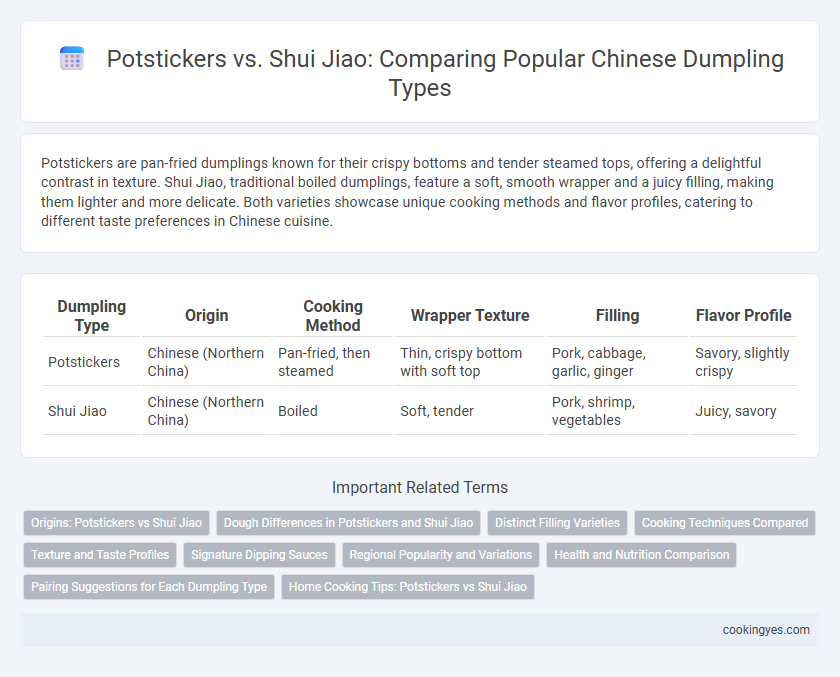Potstickers are pan-fried dumplings known for their crispy bottoms and tender steamed tops, offering a delightful contrast in texture. Shui Jiao, traditional boiled dumplings, feature a soft, smooth wrapper and a juicy filling, making them lighter and more delicate. Both varieties showcase unique cooking methods and flavor profiles, catering to different taste preferences in Chinese cuisine.
Table of Comparison
| Dumpling Type | Origin | Cooking Method | Wrapper Texture | Filling | Flavor Profile |
|---|---|---|---|---|---|
| Potstickers | Chinese (Northern China) | Pan-fried, then steamed | Thin, crispy bottom with soft top | Pork, cabbage, garlic, ginger | Savory, slightly crispy |
| Shui Jiao | Chinese (Northern China) | Boiled | Soft, tender | Pork, shrimp, vegetables | Juicy, savory |
Origins: Potstickers vs Shui Jiao
Potstickers, also known as "guotie," originate from northern China and are traditionally pan-fried to create a crispy bottom layer. Shui jiao, meaning "water dumplings," hail from northern China as well but are typically boiled or steamed for a tender texture. Both varieties share similar fillings, often combining pork, cabbage, and ginger, reflecting regional culinary influences in Chinese dumpling cuisine.
Dough Differences in Potstickers and Shui Jiao
Potstickers feature a thicker, chewier dough made from wheat flour, designed to hold up during pan-frying and achieve a crispy bottom. Shui Jiao dough is thinner and softer, often made with a higher hydration level, allowing for delicate, tender wrappers suitable for boiling or steaming. The dough texture directly influences cooking methods and the overall eating experience, with potstickers offering a robust bite and Shui Jiao providing a silky, supple mouthfeel.
Distinct Filling Varieties
Potstickers typically feature a savory filling blend of ground pork, cabbage, and garlic chives, offering a rich, umami flavor profile. Shui Jiao, a traditional Chinese dumpling, often contains diverse fillings such as minced shrimp, napa cabbage, and ginger, highlighting seasonal and regional ingredients. The variations in filling ingredients between potstickers and shui jiao reflect their unique cultural origins and culinary techniques.
Cooking Techniques Compared
Potstickers are typically pan-fried and then steamed, creating a crispy bottom with a tender, steamed top, which contrasts with Shui Jiao that are predominantly boiled or steamed, resulting in a uniformly soft and delicate texture. Pan-frying potstickers involves using oil to achieve a golden-brown crust before adding water and covering the pan to steam the dumplings, while Shui Jiao cooking relies solely on boiling water or steam to cook the dumplings evenly. These differences in cooking methods greatly influence the texture and flavor profile of each dumpling, with potstickers offering a combination of crispiness and tenderness and Shui Jiao presenting a smoother and more consistent bite.
Texture and Taste Profiles
Potstickers feature a thicker, chewier wrapper with a crispy bottom and tender top, offering a savory, slightly caramelized flavor due to pan-frying. Shui Jiao have a thinner, more delicate dough that results in a smooth, tender texture with a juicy, often pork-based filling, typically enjoyed boiled or steamed for a clean, subtle taste. The contrast lies in potstickers' crunchy exterior versus Shui Jiao's soft, supple wrapper and the richer umami notes in potstickers compared to Shui Jiao's lighter, more refreshing profile.
Signature Dipping Sauces
Potstickers feature a crispy, pan-fried exterior paired with a savory soy-based dipping sauce often mixed with vinegar and chili oil, enhancing their bold flavors. Shui jiao, traditionally boiled dumplings, are typically served with a lighter dipping sauce made from black vinegar and ginger, complementing their delicate texture. Signature sauces for both types emphasize balancing tanginess and spice to highlight the distinct textures and fillings of each dumpling style.
Regional Popularity and Variations
Potstickers, known as guotie in northern China, are pan-fried dumplings with a crispy bottom, popular in Beijing and surrounding areas, often featuring pork and cabbage fillings. Shui Jiao, traditional boiled dumplings from northern and northeastern China, have a soft texture and typically contain pork and chives or mushrooms, celebrated for their versatility in fillings across various regions. Both types reflect regional preferences, with potstickers favored for their texture contrast and Shui Jiao admired for their delicate, tender bite and extensive filling variations.
Health and Nutrition Comparison
Potstickers and Shui Jiao differ notably in cooking methods and nutritional profiles, impacting their health benefits. Potstickers are pan-fried, resulting in a higher fat content and calorie count due to oil absorption, while Shui Jiao are typically boiled or steamed, making them lower in fat and easier to digest. Both dumpling types offer protein and essential nutrients from fillings like pork, vegetables, or seafood, but Shui Jiao presents a healthier option for those seeking lower-fat, lower-calorie meals without compromising flavor.
Pairing Suggestions for Each Dumpling Type
Potstickers pair exceptionally well with a soy-vinegar dipping sauce enhanced with chili oil, complementing their crispy pan-fried texture and savory filling. Shui Jiao, with their delicate boiled wrapper and juicy interior, are best accompanied by a light ginger-soy dipping sauce or a broth-based soup to enhance their subtle flavors. Both dumpling types benefit from accompanying sides like pickled vegetables or steamed greens to balance the richness and provide complementary textures.
Home Cooking Tips: Potstickers vs Shui Jiao
Potstickers are typically pan-fried to achieve a crispy bottom while maintaining a tender steamed top, making them ideal for stovetop cooking at home with minimal oil and a lid for steaming. Shui Jiao, often boiled or steamed, require careful timing to prevent overcooking and maintain a delicate, tender wrapper, best achieved with fresh dough and precise water temperature control. Both dumpling types benefit from a well-seasoned filling and resting the dough before shaping to enhance texture and flavor during home preparation.
Potstickers vs Shui Jiao for Dumpling Types Infographic

 cookingyes.com
cookingyes.com